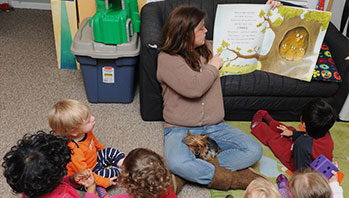- yellow objects (objects or pictures of objects from Is It Red? Is It Yellow? Is It Blue? by Tana Hoban)
- color
- dappled
- shade
- yellow
MA Standards:
Reading for Informational Texts/
RI.P.MA.1: With prompting and support, ask and answer questions about an informational text read aloud.
Reading for Informational Texts/
RI.P.MA.7: With prompting and support, describe important details from an illustration or photograph.
Counting and Cardinality/
PK.CC.MA.4: Count many kinds of concrete objects and actions up to ten, using one-to-one correspondence, and accurately count as many as seven things in a scattered configuration.
Language/L.PK.MA.4.a: With guidance and support, generate words that are similar in meaning.
Head Start Outcomes:
Literacy Knowledge/Book Appreciation and Knowledge: Asks and answers questions and makes comments about print materials.
PreK Learning Guidelines:
English Language Arts/Reading and Literature 6: Listen to a wide variety of age appropriate literature read aloud.
English Language Arts/Reading and Literature 10: Engage actively in read-aloud activities by asking questions, offering ideas, predicting or retelling important parts of a story or informational book.
Mathematics/Measurement 13: Use estimation in meaningful ways and follow up by verifying the accuracy of estimations.
Read Together: Is It Red? Is It Yellow? Is It Blue? #2

© Commonwealth of Massachusetts, Department of Early Education and Care (Jennifer Waddell photographer). All rights reserved.
STEM Key Concepts: Become aware of the different colors around them
ELA Focus Skills: Concepts of Print, Parts of a Book, Active Listening, Speaking, Interpreting Illustrations
Hold up the book Is It Red? Is It Yellow? Is It Blue? by Tana Hoban and tell children you are going to read it aloud again today.
Before You Read
Hold up the cover of the book and ask children to tell you what they recall from the book.
- After children respond, have a volunteer demonstrate how to use the book. Review looking at the dots on the bottom of a page and finding items or parts of items with those colors in the photograph. Then give children a reading focus by asking them to find the yellow objects on the pages with a yellow dot.
As You Read
Focus on the color yellow in the photographs. Encourage children to associate the color yellow with items they know and come up with a new name for the shade of yellow in some photographs. For example, the buttercup yellow box or the corn yellow sunglasses.
- Make a connection to the poem “Yellow” by Barbara Juster Esbensen. Ask children to describe the picture of the dappled yellow leaf. Ask, Do you know another word that means the same as dappled? What makes this leaf dappled?
- Encourage the child to use descriptive language.
After You Read
Hold up photographs of yellow objects in the book. Encourage children to find something in the room or out the window that is the same color. Ask questions such as,
- Is your yellow mitten lighter or darker than the pumpkin in the photograph?
- Why do you think the street sign out side is yellow like this road sign?
- Have children share yellow objects from the book that they have seen in their neighborhood.
Math Tip: For children with high-level math abilities, you may want to challenge to introduce estimation. Display the pages that show the apples. Say, Sometimes there are too many things to count, so we estimate, or make a good guess to tell how many. We try to pick a number as close as possible to the real number.
- Put 10 buttons in a clear, plastic jar and invite children to estimate how many buttons are in the jar. If they need support to make a guess ask, Do you think there are 2 buttons in this jar? 50? 10?
- Discuss children’s reasoning for their choices.
- Open the jar and count the buttons together. Ask, Which estimate was closest? (10)
- Let children work with partners. Have one child put buttons in a jar for the partner to estimate, then together count the buttons to see how close the estimate was.
